Choosing the right futures trading platform is critical for success. This guide covers 10 of the best platforms in 2025, comparing features, pricing, execution speed, and trading styles they cater to. Here’s a quick summary:
- NinjaTrader: Best for automation and strategy development. Offers advanced tools and low commissions with a lifetime plan.
- Tradovate: Cloud-based, mobile-friendly, and great for day traders with low intraday margins.
- Interactive Brokers (TWS): Ideal for professional traders with tiered pricing and global market access.
- Thinkorswim (TOS): Perfect for beginners and swing traders with strong research tools and educational resources.
- TradeStation: Advanced customization and API support for experienced traders.
- TradingView: Popular for charting and social trading with millions of instruments and Pine Script for custom indicators.
- Sierra Chart: Best for low-latency trading and detailed technical analysis.
- Quantower: Flexible workspace design with strong volume analysis tools.
- AMP Futures: Cost-effective with access to multiple platforms and ultra-low latency.
- Optimus Futures: Balanced option for all levels, offering free proprietary platforms and low commissions.
Quick Comparison:
| Platform | Monthly Cost | Best For | Execution Speed | Mobile Access | Automation Support |
|---|---|---|---|---|---|
| NinjaTrader | $0–99 | Automation | High | Limited | Strong |
| Tradovate | $0–99 | Day trading | High | Excellent | Moderate |
| Interactive Brokers | $0 | Professional trading | High | Moderate | Strong |
| Thinkorswim | $0 | Beginners, Swing | Moderate | Excellent | Moderate |
| TradeStation | $0 | Advanced customization | High | Moderate | Strong |
| TradingView | $15–60 | Charting, Social | Moderate | Excellent | Moderate |
| Sierra Chart | $26–56 | Low-latency trading | Very High | None | Strong |
| Quantower | $30–199 | Volume analysis | High | Limited | Strong |
| AMP Futures | $0 | Cost efficiency | High | Moderate | Moderate |
| Optimus Futures | $0 | All levels | Very High | Moderate | Moderate |
Each platform has strengths suited to different trading styles. Whether you’re a beginner or an advanced trader, there’s an option tailored to your needs.
Best Futures Trading Platforms | My Top 3 For Day Traders
1. NinjaTrader

NinjaTrader is a popular platform focused on futures trading, boasting a user base of 1.9 million traders. It was named the #1 Futures Broker in 2025 by BrokerChooser.com and earned the 2024 Best Trading Software award from the Stocks & Commodities Readers’ Choice Awards.
Platform Features
NinjaTrader offers access to over 100 futures products, including commodities, stock index futures, and crypto futures contracts. These are available across major exchanges like CME Group, Eurex, Coinbase Derivatives, and ICE. The platform provides advanced charting tools, backtesting capabilities, and unlimited simulation for refining trading strategies – all at no cost. Traders can also customize their experience by integrating thousands of add-ons or creating their own indicators and automated strategies using NinjaScript (based on C#).
Additionally, NinjaTrader provides robust support through its help center, live chat, and free daily livestreams led by industry professionals. The platform is accessible on desktop, web, and mobile devices, ensuring flexibility for users.
Pricing (USD)
NinjaTrader offers three pricing tiers, catering to different trading needs and budgets:
| Plan | Monthly Fee | Micro Contract Commission | Standard Contract Commission |
|---|---|---|---|
| Free | $0 | $0.39 per side | $1.29 per side |
| Monthly | $99 | $0.29 per side | $0.99 per side |
| Lifetime | $1,499 (one-time) | $0.09 per side | $0.59 per side |
The Lifetime plan provides the lowest commission rates, making it appealing for high-volume traders. However, additional costs apply, such as market data subscriptions starting at $48 per year and a $35 minimum account activity fee for Free Plan users who don’t execute trades within a month. Optional features, like SuperDOM Static, come with extra fees (e.g., $0.10 per contract).
Execution Speed
Designed with active futures traders in mind, NinjaTrader offers advanced order execution tools and multiple routing options, including Rithmic and CQG Desktop, each charging $0.25 per contract. These features, combined with the platform’s automation tools, make it suitable for a range of trading styles.
Trading Style Compatibility
NinjaTrader excels in supporting automated trading strategies. Using NinjaScript, traders can develop complex automated systems, while the Automated Trading Interface (ATI) allows integration with external trading signals and black box systems. This automation not only enhances execution speed but also helps traders maintain discipline by eliminating emotional decision-making.
"Strategy automation is the ability to take a backtested set of rules and apply them to live or simulated market data. These entry and exit rules are processed and executed automatically, hands-free. This is true programmed trading, instilling discipline and consistency while helping remove emotional decisions from your trading."
- NinjaTrader Team, November 2024
Day traders, in particular, benefit from competitive intraday margins – $50 for Micros and $500 for E-Minis – offering greater buying power. These features make NinjaTrader a solid choice for both day traders and algorithmic setups.
Platform Integration
NinjaTrader offers extensive integration options, supporting connections with brokers like NinjaTrader Brokerage and Interactive Brokers. It also works with trading applications such as TradeStation and eSignal. For developers, the platform supports tools like Visual Studio .NET, Visual Basic, Delphi, and MS Excel, allowing for third-party enhancements. These integrations provide flexibility for traders with diverse needs.
That said, the platform’s interface may feel overwhelming for some users, especially beginners. As noted by NerdWallet’s Lead Writer Sam Taube:
"NinjaTrader offers an information-rich and highly customizable trading platform for experienced futures traders who already have significant know-how and resources to devote to trading."
2. Tradovate
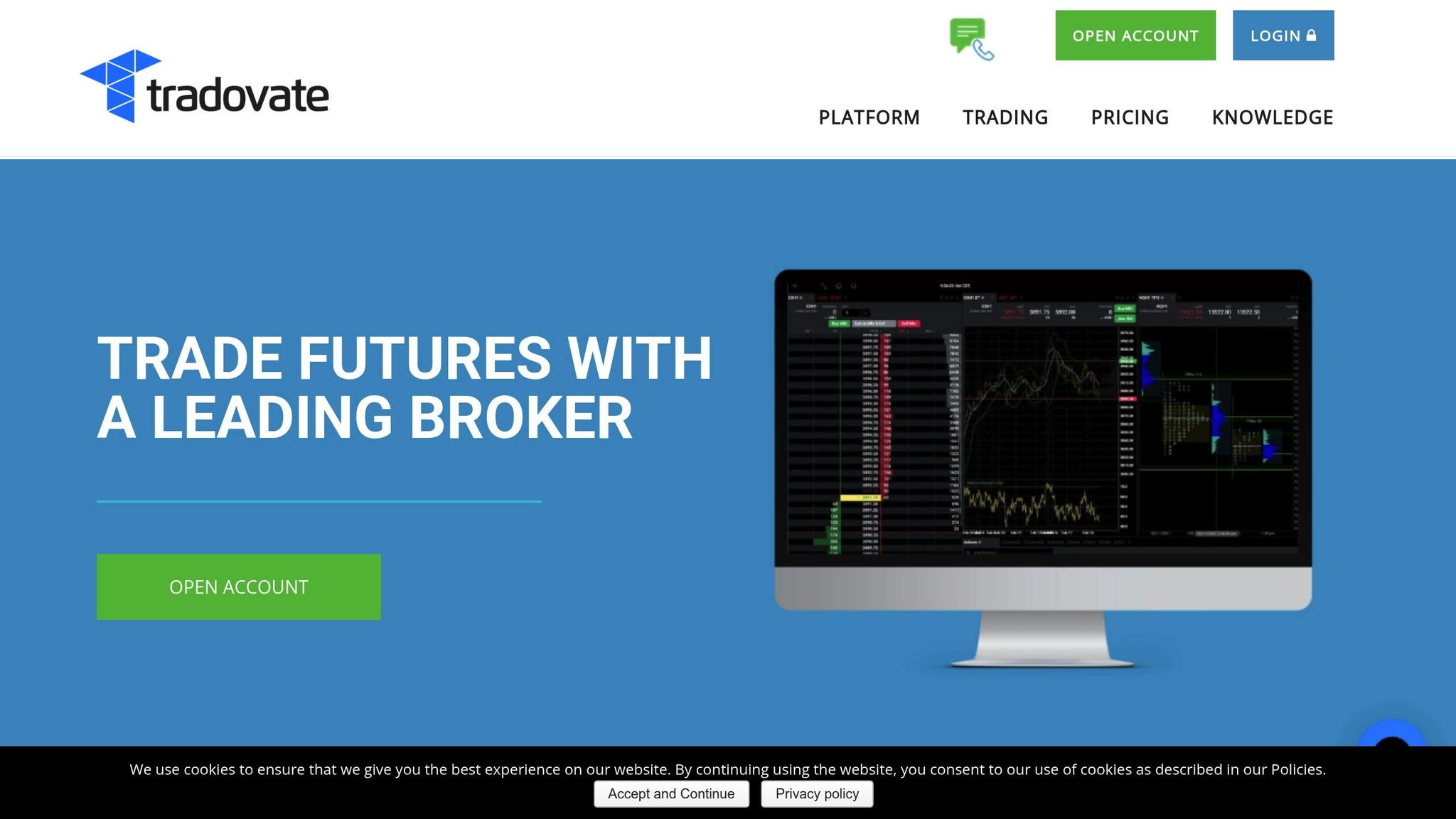
Tradovate, launched in 2015, is a cloud-based futures trading platform tailored for active traders. Known for its speed and compatibility across multiple devices, it provides access to over 40 specialized trading tools and supports trading on major exchanges like CME Group, Coinbase Derivatives, ICE, Eurex, and MIAX. Its robust features cater to a wide range of trading strategies.
Platform Features
Tradovate offers a comprehensive suite of tools for market analysis and trade execution. Key features include:
- Configurable hotkeys for quick actions
- Advanced charting tools
- Real-time quotes
- Efficient order management
- Depth of Market (DOM) modules
- One-click order entry
- Bracket orders for managing trades
The platform also includes a Market Replay feature, letting traders backtest strategies with historical data, and a simulated trading environment for practice. Advanced tools like TPO Profile Charts, the Pulse Indicator, and Order Flow+ provide deeper market insights. Additional features, such as the Options Chain, Spread Matrix, and Group Trade, are designed for analyzing and executing complex derivatives strategies. A dedicated Performance Center helps traders monitor their progress and refine their strategies over time.
Pricing (USD)
Tradovate offers a tiered pricing structure to accommodate traders with varying volumes:
| Plan | Monthly Fee | Micro Futures | Standard Futures | Nano & Event Contracts |
|---|---|---|---|---|
| Free | $0 | $0.39 per side | $1.29 per side | $0.20 per side |
| Monthly | $99 | $0.29 per side | $0.99 per side | $0.15 per side |
| Lifetime | $1,499 (one-time) | $0.09 per side | $0.59 per side | $0.05 per side |
All plans include top-of-book market data, advanced trading tools, and access to simulated trading. The Lifetime plan can also be paid in four installments of $499. Keep in mind, exchange, clearing, and NFA fees apply to all plans, and the listed rates are per contract, per side – so a full round-turn trade costs double.
Execution Speed
Tradovate’s cloud-based infrastructure ensures fast order execution across all devices. Built with active traders in mind, it employs two-factor authentication for security and adheres to NFA regulations. The Tradovate Pulse mobile app offers a simplified interface for quick trades while on the go.
Trading Style Compatibility
Tradovate supports a variety of trading styles:
- Day Traders: Benefit from low intraday margins starting at $50 for micro e-mini futures, boosting buying power for frequent trades.
- Scalpers and High-Frequency Traders: Enjoy one-click order entry and customizable hotkeys for rapid execution.
- Swing Traders: Take advantage of detailed charting and market analysis tools, making it highly effective for longer-term strategies.
- Automated Trading: Features rule-based strategy development tools and API access for creating sophisticated programmatic strategies [33, 35].
Platform Integration
Tradovate allows seamless trading across devices, including Mac, PC, iPad, Android, and iPhone. Custom dashboards and charts ensure a consistent experience, while integration with third-party charting tools lets traders personalize their setups. The platform also supports custom indicators and automated strategies, offering the flexibility that professional traders demand.
3. Trader Workstation (Interactive Brokers)
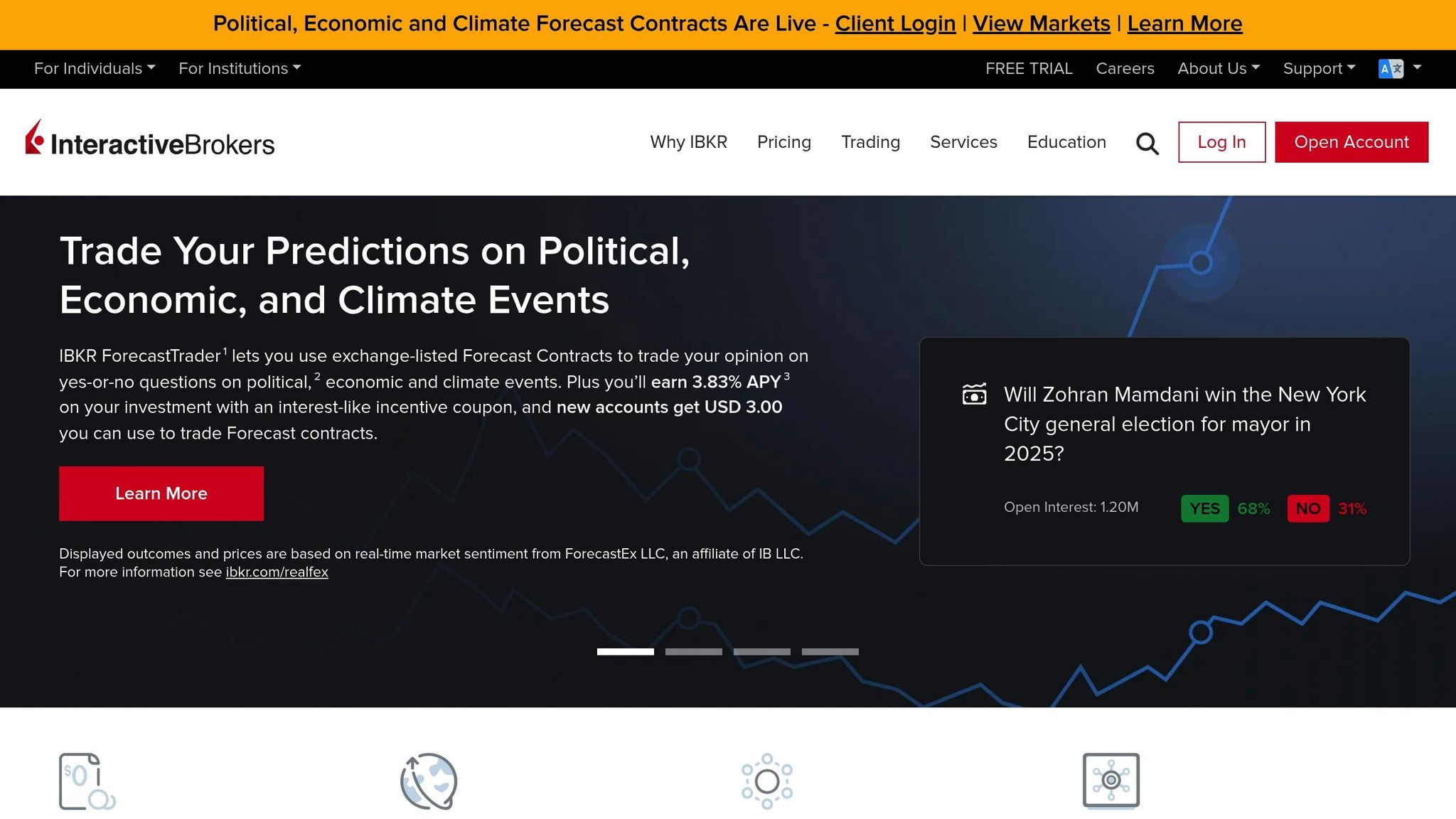
Trader Workstation (TWS) is the flagship platform from Interactive Brokers, designed to deliver speed, flexibility, and access to global markets. With TWS, users can trade futures on over 30 exchanges worldwide, alongside stocks, options, currencies, bonds, and funds across more than 160 markets – all from one platform. Let’s dive into the features, pricing, and tools that make TWS a standout choice.
Platform Features
TWS offers two main interfaces: Mosaic and Classic. Mosaic is a customizable workspace that combines trading, charting, order management, and portfolio tools into one intuitive layout. Classic, on the other hand, is tailored for fast order entry and provides direct access to over 100 order types and trading algorithms.
For futures traders, TWS includes tools like ComboTrader and SpreadTrader, which streamline complex strategies, and an Index Arbitrage Meter for evaluating arbitrage opportunities. The platform also uses IB SmartRouting™, a feature designed to help traders achieve the best execution for their trades.
Additional tools such as Risk Navigator, Model Navigator, and Option Analytics provide real-time monitoring of risk and portfolio performance. Traders can also track account balances, margin requirements, and portfolio data in real time. For those looking to test strategies without financial risk, TWS includes a paper trading feature.
"Power your trading with Trader Workstation (TWS) – our flagship platform built for active traders and investors who demand speed, flexibility and global markets access." – Interactive Brokers LLC
Pricing (USD)
Interactive Brokers offers two pricing models for futures trading: tiered and fixed commission structures. The tiered model reduces costs as your monthly trading volume increases:
| Monthly Volume | Tiered Commission | E-micro Futures | Bitcoin Futures (BRR) | Ethereum Futures (ETH) |
|---|---|---|---|---|
| ≤ 1,000 contracts | $0.85/contract | $0.25/contract | $5.00/contract | $3.00/contract |
| 1,001 – 10,000 | $0.65/contract | $0.20/contract | $4.20/contract | $2.55/contract |
| 10,001 – 20,000 | $0.45/contract | $0.15/contract | $3.40/contract | $2.10/contract |
| > 20,000 contracts | $0.25/contract | $0.10/contract | $2.60/contract | $1.65/contract |
The fixed pricing model charges a flat $0.85 per contract, regardless of volume. Both pricing structures include exchange and regulatory fees, but additional clearing fees may apply for certain products like Small Exchange Futures.
For example, trading one ES Futures contract under the tiered plan costs $2.25 in total: $0.85 for IBKR execution, $1.38 in exchange fees, $0.00 in clearing fees, and $0.02 in regulatory fees.
Execution Speed
TWS is built with execution speed in mind. Its IB SmartRouting™ system scans multiple exchanges to find the best available prices for trades. The platform supports advanced order types and algorithms, which help traders optimize execution and reduce market impact. Additionally, one-click trading functionality ensures rapid order entry – a crucial feature for time-sensitive strategies in futures trading. TWS’s focus on fast execution makes it a strong choice for traders who prioritize precision and timing.
Trading Style Compatibility
TWS caters to intermediate and advanced traders who need a platform capable of handling multiple asset classes. Active traders benefit from tools like real-time risk monitoring, while swing traders can utilize its advanced charting and portfolio analytics for managing longer-term positions. For those interested in automation, TWS supports API integration, allowing traders to develop custom strategies and implement algorithmic trading. This versatility makes it a solid option for a wide range of trading styles.
Platform Integration
The platform’s extensive API integration allows traders to automate strategies and create tailored solutions. TWS also connects with third-party systems like NinjaTrader and MultiCharts, enhancing market data and order placement capabilities. Its customizable layouts let users design a trading environment that aligns with their specific strategies and preferences. These integration features reinforce TWS as a powerful and flexible trading solution for both retail and institutional users.
4. Thinkorswim (TOS)
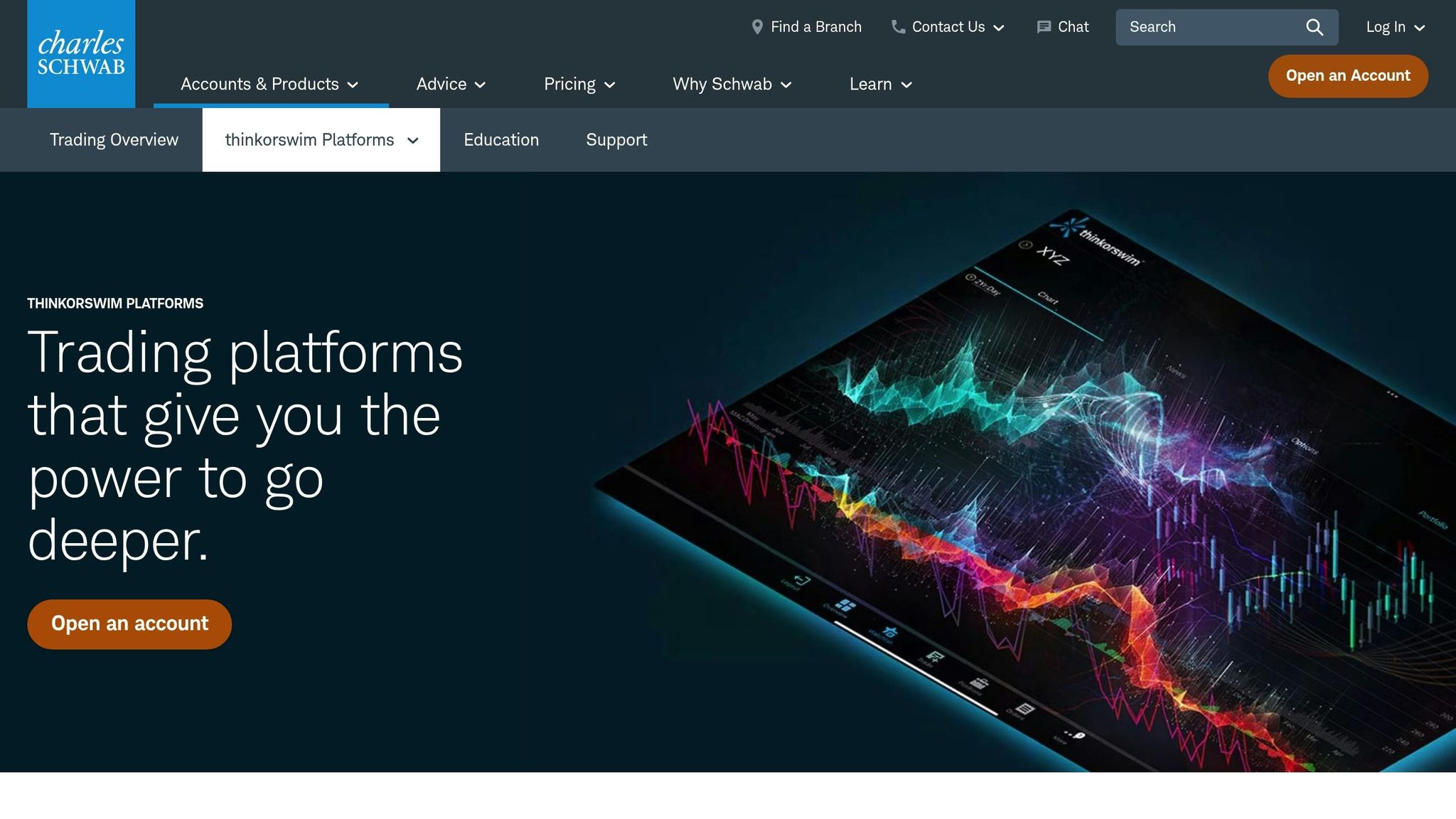
Thinkorswim (TOS) is the flagship trading platform from TD Ameritrade, tailored for active traders who need advanced tools to navigate the futures markets. With 24/7 access to futures trading, TOS is designed to meet the demands of both beginners and seasoned traders alike.
Platform Features
Thinkorswim offers a range of customizable tools to enhance the trading experience. The platform includes features like the Active Trader Subtab for quick order execution and the Futures Trader Tab, which provides a professional-grade trading environment. Traders can take advantage of one-click order entry and a bid/ask ladder for fast and efficient order placement. The platform also supports advanced order types, such as bracket orders, which allow users to set both a limit and a stop order simultaneously, simplifying trade management.
Customizable charts are another standout feature, enabling traders to perform detailed technical analysis and fine-tune their entry and exit points. Dashboards provide essential data, including tick values, margin requirements, and live news updates, helping traders manage risk effectively. A particularly valuable tool is paperMoney®, which lets users practice trading in a simulated market environment before putting real money on the line. All these features work together to support a variety of trading strategies.
Pricing (USD)
Thinkorswim has a transparent pricing model for futures trading. The cost is $2.25 per contract for both futures and futures options, plus any applicable regulatory and exchange fees. This pricing applies whether trades are executed online or via a broker. The straightforward fee structure makes it a practical choice for active traders, including day and swing traders.
Trading Style Compatibility
TOS is a strong fit for traders who rely on technical analysis and intraday strategies. It supports both bullish and bearish approaches, offering tools like OCO (One Cancels the Other) orders and drag-and-drop functionality for quick adjustments to stop and limit orders.
One day trader shared their experience with the platform:
"I day trade on it everyday using the desktop version. It works great! I don’t use any complicated setups, multiviews or anything like that. It’s more important that you find good stocks to trade on." – This_Marvelous_Guy
Another trader highlighted its effectiveness for scalping:
"Use the pc desktop app. It’s powerful. I scalp easily using OCO on either the chart or order book ladder. Easily drag a stop or limit with the click of the mouse – I have a template to create a stop 20 values lower than entry so it doesn’t instantly hit and I quickly adjust it to where I need." – buruskeee
Platform Integration
Thinkorswim includes thinkScript, a feature that allows traders to create custom trade signals and analyze strategies in real-time. While thinkScript doesn’t execute trades automatically, it’s a powerful tool for monitoring and testing strategies. For those seeking automation, many traders pair TOS with external platforms or scripts for trade execution, while relying on thinkScript for signal generation and analysis. This setup lets traders start with simple strategies, refine them over time, and stay aligned with market trends.
Additionally, the paperMoney® virtual trading environment provides a safe space for users to test strategies without financial risk, making it an excellent resource for both newcomers and experienced traders looking to refine their approaches.
5. TradeStation
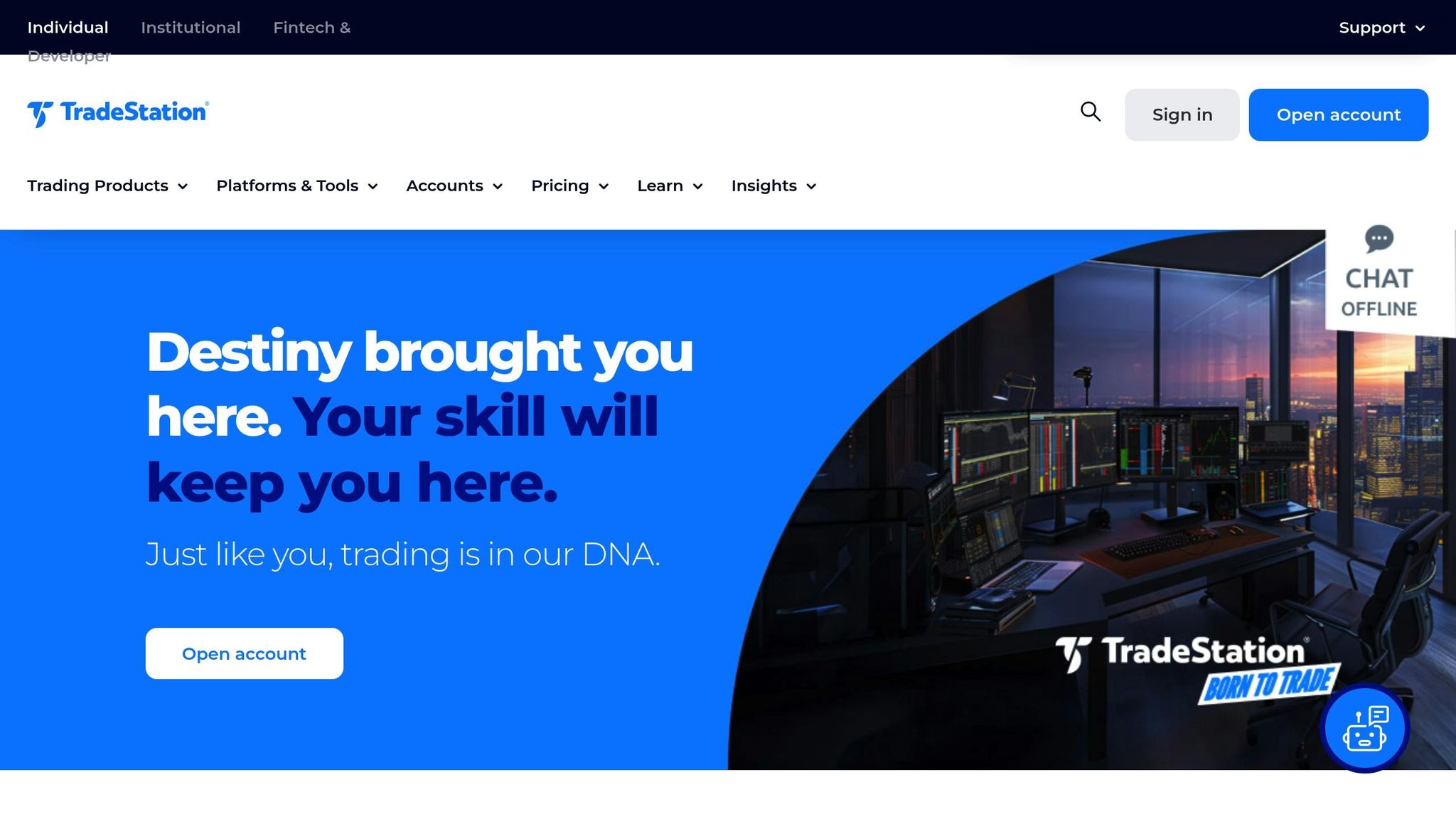
TradeStation is a robust platform designed for futures traders who value advanced technology and intuitive tools. With access to over 600 futures and futures options products, it provides ample opportunities to diversify trading strategies across various markets. What makes TradeStation stand out is its focus on equipping traders with customizable tools and seamless integrations.
Platform Features
TradeStation offers a suite of features tailored to meet the needs of futures traders. Its proprietary programming language, EasyLanguage®, empowers users to create custom trading strategies without requiring deep coding expertise. The platform also includes RadarScreen®, a tool for real-time market monitoring that allows users to track multiple markets at once. Advanced charting capabilities, customizable indicators, and efficient backtesting tools help traders refine and validate their strategies.
A standout feature is the continuous contract view, which simplifies futures trading by automatically rolling contracts. This eliminates the hassle of managing contract expirations, making trading more straightforward. Additionally, TradeStation integrates with TradingView, combining TradingView’s charting capabilities with TradeStation’s execution strengths.
Pricing (USD)
TradeStation’s pricing structure is straightforward and competitive. Standard futures contracts are priced at $1.50 per contract, per side, while micro futures cost $0.50 per contract, per side. Futures options are available for $0.85 per contract, per side. These rates apply equally to traders within and outside the U.S.
Real-time market data is included at no additional cost, but traders who do not generate at least $40 in monthly futures commissions may face a $40 monthly data fee after a 90-day grace period.
Trading Style Compatibility
TradeStation’s platform is adaptable to a variety of trading styles. As the company puts it:
"The most important tool for any natural-born trader sits between their ears. Your brain defines you as a trader, not the tools you use. That’s why we give traders the ability to choose trading technology beyond our own award-winning† platforms."
The platform supports algorithmic trading through EasyLanguage® and its API. Day traders benefit from fast order execution, while swing traders can utilize advanced charting and backtesting tools for longer-term strategies. For those seeking even more flexibility, TradeStation’s API integrates with platforms like Option Alpha, MultiCharts, and QuantConnect, enabling advanced traders to connect their preferred tools while leveraging TradeStation’s execution capabilities.
Platform Integration
One of TradeStation’s key strengths is its integrated approach to trading. The platform allows users to manage futures, equities, and options within a single interface, simplifying portfolio management and making multi-asset strategies easier to execute. Its open API supports extensive customization and third-party integrations, enabling traders to build personalized trading solutions or link existing tools to TradeStation’s execution engine.
The TradingView integration is another highlight, allowing traders to execute trades directly from TradingView charts while taking advantage of TradeStation’s competitive pricing and execution quality. In 2024 alone, TradeStation delivered $31,146,028.87 in total price improvements, with an average of $2.11 saved per options contract.
6. TradingView
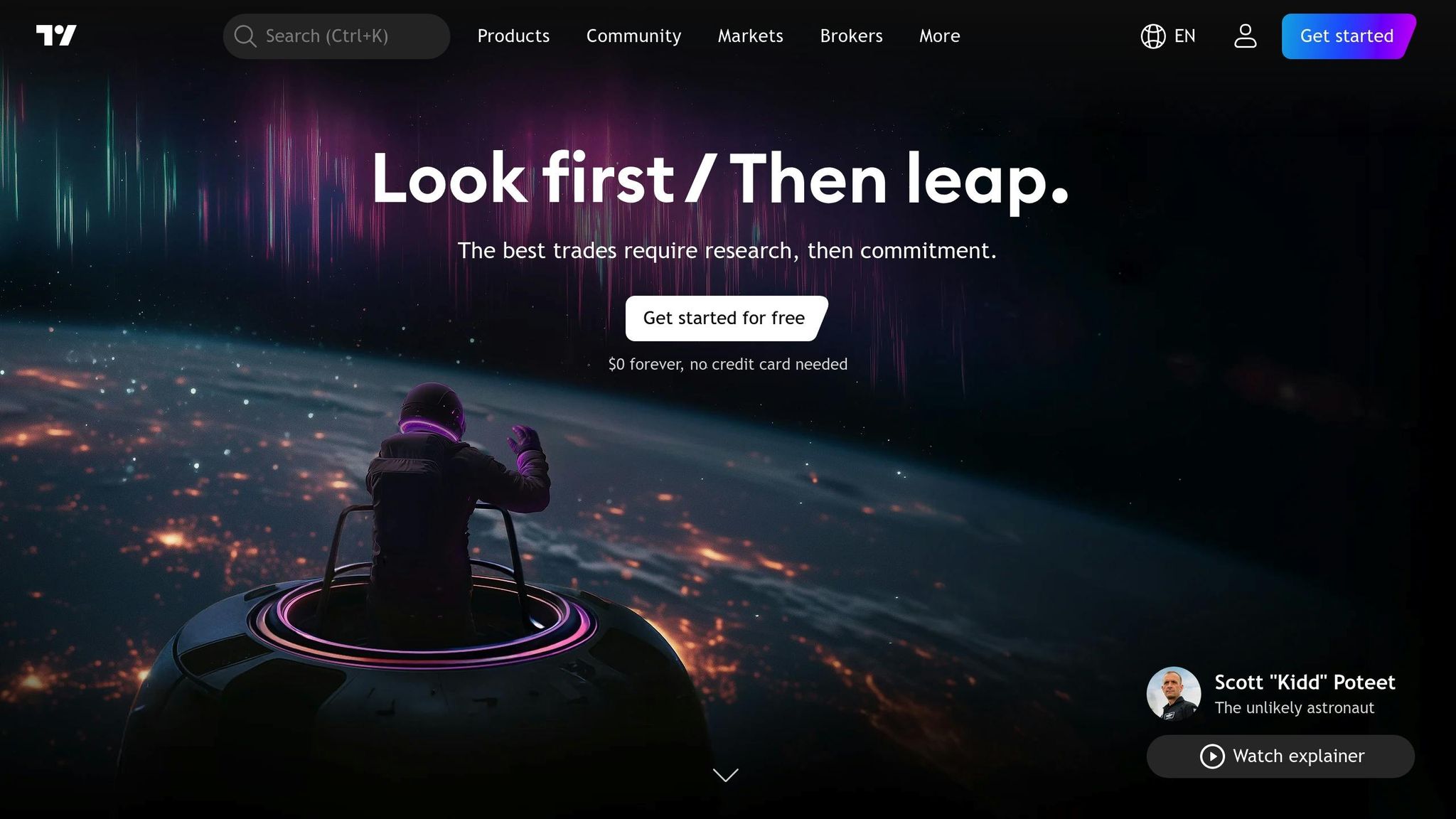
TradingView is a web-based charting and analysis platform trusted by over 100 million users worldwide. It offers access to an impressive 3,539,722 instruments from global markets.
Platform Features
TradingView provides a robust suite of tools for traders, including advanced charting, real-time data, and analysis. With access to over 3.5 million instruments, it stands out as a comprehensive resource for traders. The platform includes 400+ built-in indicators and strategies and a staggering 100,000+ public indicators contributed by its community. It also boasts 110+ smart drawing tools and customizable alerts for prices and indicators.
For those who want to create their own tools, TradingView offers Pine Script, a programming language that allows users to develop custom studies and signals. This feature fuels a thriving community where ideas and strategies are shared openly. Additionally, the platform supports continuous futures contracts, making technical analysis and backtesting more efficient.
One standout feature is its paper trading functionality, which provides a risk-free environment for testing strategies. Traders also benefit from real-time market data, live news feeds, and detailed fundamental data on U.S. companies, creating a well-rounded trading experience.
As AMP Futures describes it:
"TradingView is an advanced financial visualization platform with the ease of use of a modern website. Whether you are looking at basic price charts or plotting complex spread symbols with overlayed ratios, we have the tools and data you need."
These features are complemented by flexible pricing plans tailored to various trading needs.
Pricing (USD)
TradingView offers a tiered subscription model with options for every level of trader. The plans range from a free Basic option to more advanced, professional-grade subscriptions.
| Plan | Monthly Cost | Key Features |
|---|---|---|
| Basic | $0 | Limited charts, indicators, and alerts |
| Essential | $13.99 | More charts per tab, additional indicators |
| Plus | $28.29 | Enhanced features for active traders |
| Premium | $56.49 | Professional-level tools and data |
| Expert | $99.95 | Advanced features for serious traders |
| Ultimate | $199.95 | Full feature set with priority support |
Note: Prices reflect annual billing rates; monthly billing costs are higher.
Futures traders may need to subscribe to additional real-time data services. For instance, global commodities data from CME, CBOT, COMEX, and NYMEX is available for $7.00 per month for non-professional users. Payments are accepted via credit cards, PayPal, Apple Pay, and cryptocurrency.
Trading Style Compatibility
TradingView’s tools cater to a variety of trading styles. Day traders benefit from real-time data and advanced charting, while swing traders can utilize its extensive indicator library and backtesting features, particularly with continuous futures contracts. The platform’s community of over 50 million active investors provides a space for sharing ideas and strategies, enhancing the experience for all users. Algorithmic traders, on the other hand, can leverage Pine Script to develop and refine custom trading strategies.
Platform Integration
TradingView goes a step further with its seamless integration with over 100 verified brokers, ensuring smooth execution and connectivity for traders. This includes major names like AMP Futures, Optimus Futures, Interactive Brokers, NinjaTrader, and TradeStation.
Highlighting its impartiality, TradingView explains:
"We are not a broker. We make our money only through low-cost subscriptions and ads. For us, objectivity is excellence."
This neutrality allows the platform to offer direct connections to broker servers, reducing execution delays. AMP Futures, for example, was voted "Best Futures Broker" for 2023 and 2024 on TradingView, based on feedback from verified users.
Connecting your TradingView account to a broker is straightforward. After logging into both accounts, you simply open the Trading Panel, find your broker, and connect. Some brokers may require funding the account before enabling the connection, but once set up, you can execute orders directly from TradingView charts while maintaining the broker’s pricing and execution quality.
7. Sierra Chart
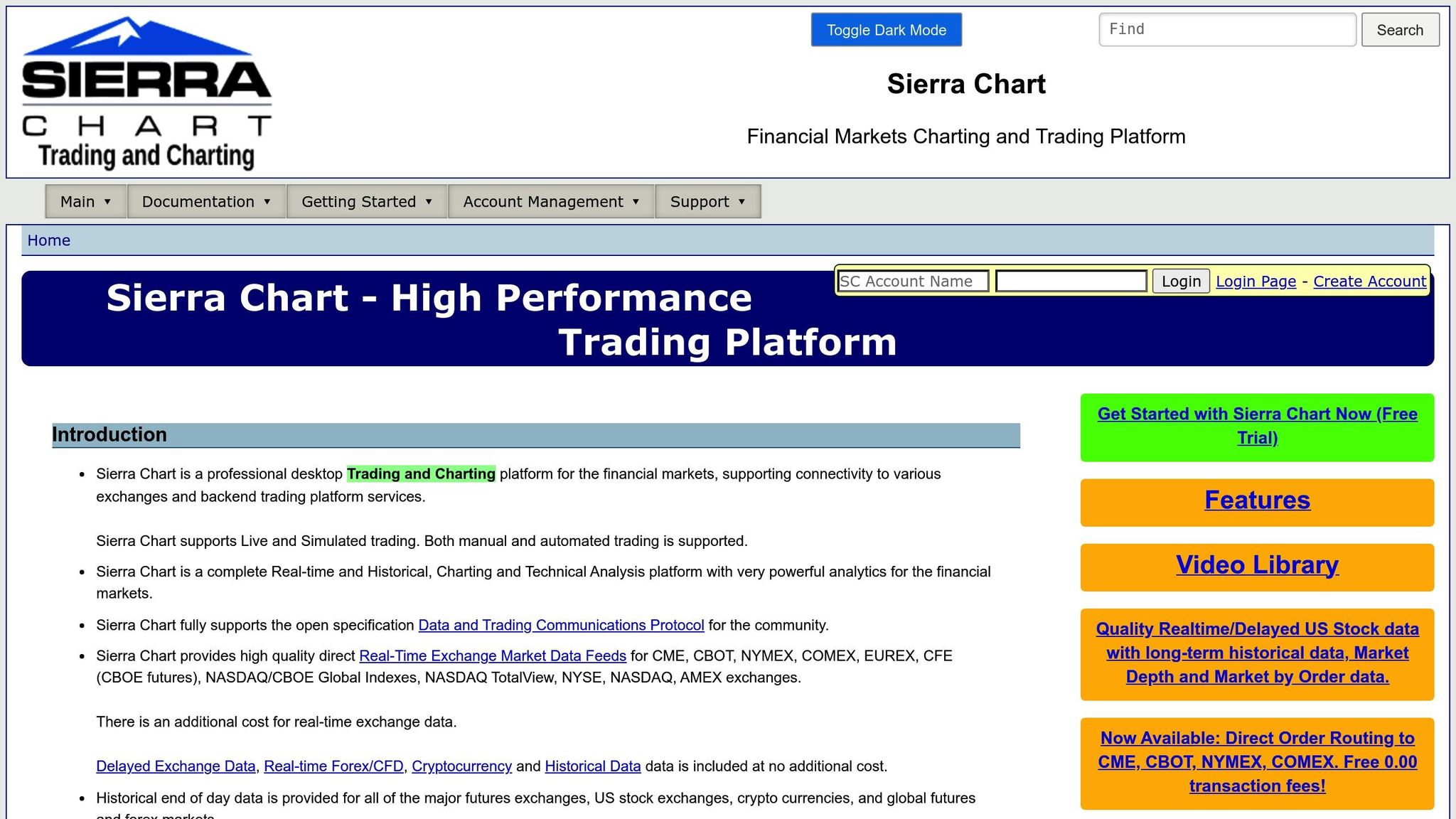
Sierra Chart is a desktop trading platform designed with serious futures traders in mind. Known for its speed, reliability, and customization options, it’s built on a robust C++ architecture that ensures stability during high-pressure market moments. Below, we’ll dive into its features, pricing, execution speed, and compatibility with various trading styles.
Platform Features
Sierra Chart provides a suite of professional tools tailored for futures trading. With over 300 technical studies integrated into the platform, traders have access to a wide range of analytical tools. The platform processes real-time market data with microsecond accuracy, and its Depth of Market (DOM) feature allows for single-click order execution – essential for fast-paced trading environments.
For those who prefer customization, Sierra Chart supports creating custom formulas for indicators and offers advanced tick-by-tick backtesting capabilities. Its modular design enables users to expand functionality by downloading additional study packages. Whether you’re trading manually or using automated strategies, the platform accommodates both live and simulated trading.
Sierra Chart also connects directly to major futures exchanges, supporting a range of markets including stocks, futures, indexes, forex, and options.
Pricing (USD)
Sierra Chart offers a tiered subscription model with five main service packages, each catering to different trading needs:
| Service Package | Monthly Cost | Key Features |
|---|---|---|
| Base Standard (Package 3) | $26.00 | Core platform features |
| Base with Advanced Features (Package 5) | $36.00 | Additional tools and capabilities |
| Integrated Standard (Package 10) | $36.00 | Includes external service support |
| Integrated with Advanced Features (Package 11) | $46.00 | Full features plus external connections |
| Advanced with Market by Order (Package 12) | $56.00 | Access to professional-grade order flow data |
The base packages focus on Sierra Chart’s internal features, while the integrated packages offer connections to external services like Interactive Brokers, CQG, and Rithmic. Sierra Chart’s Denali Exchange Data Feed is also supported. Keep in mind that real-time futures data may incur additional exchange fees, though some brokers provide free CQG feeds to help reduce costs. Discounts are available for multi-month subscriptions, with annual plans lowering the cost to as little as $17.16 per month for certain packages.
Execution Speed
Sierra Chart stands out for its execution speed, thanks to its optimized C++ architecture. The platform can process up to 100,000 price updates per second, ensuring smooth performance even during volatile market conditions. By using direct connections and avoiding frameworks like Java or .NET, Sierra Chart minimizes latency. Additionally, for trading services that support OCO (order cancels order) and bracket orders, the platform employs server-side processing to further reduce delays.
"Sierra Chart is renowned for its performance and stability, which are critical for active traders who need a reliable platform during high market volatility." – Paul Holmes
Trading Style Compatibility
Sierra Chart caters to a variety of trading styles, making it versatile for different strategies.
- Day Traders benefit from its real-time data integration, advanced charting tools, and single-click DOM execution, all of which are critical for reacting quickly to market movements.
- Scalpers and High-Frequency Traders will find its microsecond-level data precision and rapid order execution particularly useful.
- Swing Traders can take advantage of the platform’s robust technical analysis tools, built-in studies, and custom indicator options. Its backtesting systems allow traders to analyze strategies using historical data.
- Algorithmic Traders will appreciate the Advanced Custom Study Interface and Language (ACSIL) and the ability to integrate with Excel-compatible spreadsheets for automated trading systems.
Platform Integration
Sierra Chart offers extensive integration capabilities, enhancing its functionality. It supports trading and order routing for major exchanges using FIX and DTC protocols, ensuring reliable communication and execution. The platform also provides direct real-time data for various markets, including futures, stocks, cryptocurrencies, indexes, forex, and CFDs, without relying on external services. Historical daily and detailed intraday data are also available, allowing traders to tailor their setups to specific market needs.
With its blend of speed, reliability, and advanced features, Sierra Chart remains a trusted choice for professional futures traders navigating demanding market conditions.
8. Quantower
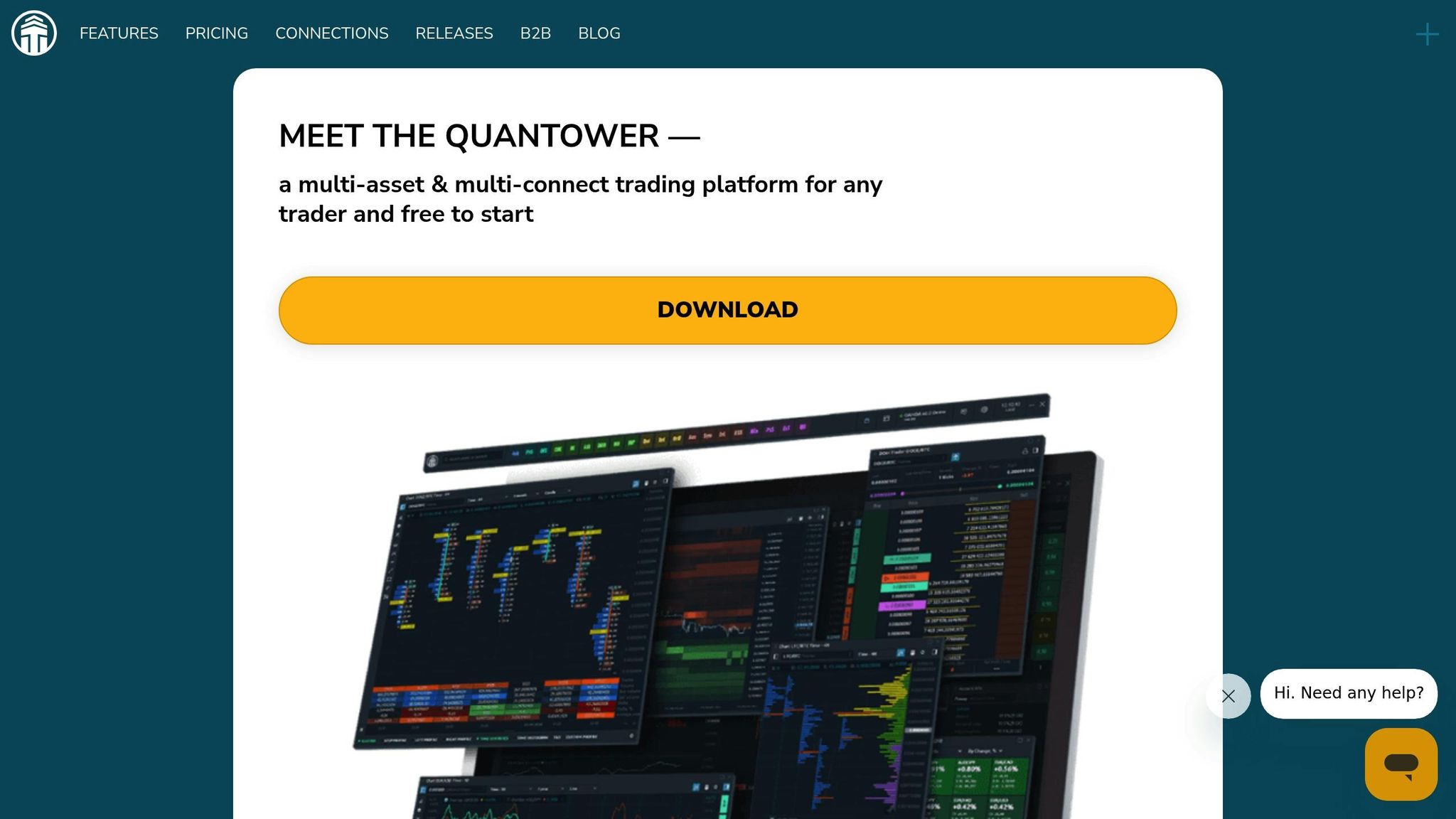
Quantower is a multi-asset trading platform built with speed and adaptability in mind. Its modular design lets users create a workspace tailored to their needs, with panels that serve specific functions and can be arranged across multiple screens. The platform has received positive feedback on Trustpilot, with users highlighting its user-friendly design and versatility.
Platform Features
Quantower’s panel-based setup allows users to organize and customize their workspace by grouping, arranging, or saving panels as templates. This flexibility ensures that traders can design their interface to suit their unique workflows.
The platform stands out in volume analysis, offering tools like Cluster Chart, Volume Profile, Historical Time & Sales, and Time Statistic & Histogram. Its DOM Surface feature provides insights into market liquidity and order flow by displaying limit orders and liquidity changes at each price level.
Quantower supports a variety of chart types, including Time-based, Tick, Heiken-Ashi, Range Bars, Renko, Kagi, Point & Figure, and Line Break charts. It also includes a robust collection of technical indicators and drawing tools for in-depth analysis. For quick execution, the platform offers one-click trading and customizable hotkeys.
With connections to over 60 brokers, exchanges, and data feeds, Quantower enables simultaneous connections across different markets. This allows users to create spreads and synthetic symbols with ease. The platform also offers flexible pricing options to accommodate different trading preferences.
Pricing (USD)
Quantower provides both free and paid plans. The All-in-One License unlocks all features, connections, and updates for $70 per month, with discounts available for longer commitments – 20% off for six months and 30% off for a year. A lifetime license is also available for a one-time payment.
For traders who prefer to pay for specific features, individual extensions are available:
| Extension | Monthly Cost |
|---|---|
| DOM Surface | $30.00 |
| Volume Analysis | $35.00 |
| Advanced Features | $30.00 |
| Power Trades | $25.00 |
| TPO Profile Chart | $20.00 |
| Option Trading | $50.00 |
| Multi-asset Package | $50.00 |
| Crypto Package | $40.00 |
All plans come with a 10-day money-back guarantee. Note that market data from third-party exchanges must be purchased separately.
Execution Speed
Quantower places a strong emphasis on execution speed, transparency, and security. Features like one-click trading and customizable hotkeys allow traders to act quickly in fast-moving markets. The platform’s design isolates execution functions to reduce delays during trade placement.
Trading Style Compatibility
Quantower’s wide range of tools caters to various trading styles. Day traders will appreciate the real-time volume analysis and quick execution features like one-click trading and hotkeys. Swing traders can take advantage of advanced charting tools and diverse chart types to spot trends and reversals. For those using automated strategies, the platform provides an open C# API, a strategy scripting environment, and trading simulation tools to test custom indicators and algorithms.
Platform Integration
With its open C# API, Quantower offers extensive opportunities for customization and integration. Traders can develop their own tools, such as automated strategies, technical indicators, or custom broker connections. The platform’s multi-broker connectivity supports simultaneous access to futures, forex, options, and cryptocurrency markets.
"I have been so surprised by Quantower. The most pleasant surprise of all! The interface, the features, the flexibility, the ease of use are of a class of their own…"
– Peter Avgeris
"An incredible platform to analyze the price with all the volume tools that are of great help, I use it for Futures but can be used in Options, Cryptos, and…"
– Benny
9. AMP Futures
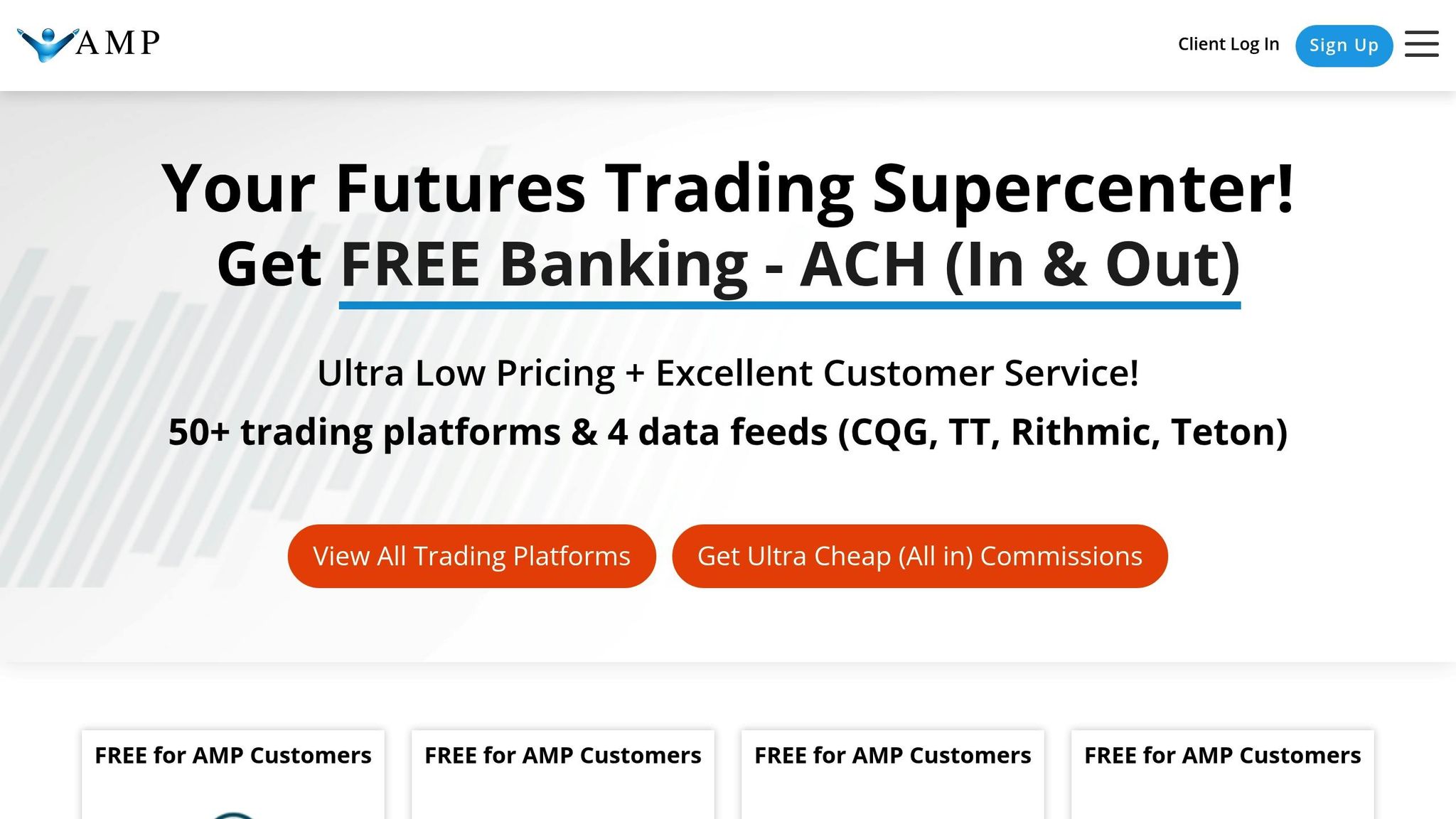
AMP Futures stands out among U.S. futures platforms by focusing on cost-effective trading and high-speed execution. This broker offers access to over 50 trading platforms and multiple data feeds, giving traders plenty of flexibility to tailor their trading setups to their needs. Recognized for its performance, AMP Futures earned the title of "Best Futures Broker" for 2023 and 2024 on TradingView, based on feedback from verified users.
Platform Features
AMP Futures takes a unique approach by offering access to a variety of specialized trading platforms instead of relying on a single proprietary system.
- Scaled Dynamics: This platform delivers high-speed order routing, automated execution, built-in risk management tools, and sharable cloud-based workspaces.
- FutureSource: Designed for traders who need in-depth market insights, FutureSource combines real-time and historical data with advanced charting tools. It also includes options analysis, alerts, news feeds, weather maps, and Excel integration for custom analytics.
- CQG Spreader: Built for professional traders, this platform excels in ultra-low latency execution. It offers advanced order management, cross-account spread trading, customizable spreads, and global market access. Traders can also integrate custom C++ algorithms using its Custom Algo SDK to develop automated strategies.
AMP Futures provides 24/7 customer and trade desk support, accepts deposits in all major currencies, and offers foreign language assistance to cater to international clients. These features, combined with competitive pricing and integration options, make it a strong contender in the futures trading market.
Pricing (USD)
AMP Futures keeps its fees transparent and competitive, offering two primary pricing models: volume-tiered and flat rate.
- Volume-tiered pricing: Requires a minimum deposit of $100.
- Flat-rate pricing: Requires a $10,000 minimum deposit.
For Micro E-mini S&P 500 futures, the cost per contract adjusts based on trading volume:
| Monthly Volume | Cost per Contract |
|---|---|
| Under 1,000 contracts | $0.44 |
| 1,001–4,999 contracts | $0.43 |
| 5,000–9,999 contracts | $0.42 |
| Over 10,000 contracts | $0.41 |
Additional costs include $595 per month for the CQG Integrated Client, with an extra $1,400 per month for CQG Spreader features. Traders can also opt for an unlimited trading plan, which offers commission-free trades for an annual fee of $1,000.
AMP Futures does not charge inactivity fees or impose monthly volume requirements. However, additional fees apply for specific services, such as $30 for wire withdrawals, $30 for currency conversions, and $25 per contract for margin liquidations.
Execution Speed
Fast and reliable trade execution is a priority for AMP Futures. The CQG Spreader Core executes orders in under one millisecond, offering ultra-low latency for time-sensitive trading strategies. To ensure flexibility, the broker supports multiple data feeds, including Teton, CQG, and Rithmic, allowing traders to choose the best routing for their needs. FutureSource further enhances order flow with its direct integration into Continuum’s trade execution system.
Trading Style Compatibility
AMP Futures caters to a wide range of trading styles through its diverse platform offerings.
- Day traders benefit from ultra-low latency and competitive commissions, with $400 S&P 500 day trading margins and $40 Micro E-mini S&P 500 margins providing accessible leverage.
- Swing traders can take advantage of FutureSource’s comprehensive market data and analytics tools.
- Automated traders have access to the CQG Spreader’s Custom Algo SDK for integrating advanced algorithms, while Scaled Dynamics supports collaboration with its cloud-based workspaces.
Excel integration is another useful feature, enabling custom analysis and position tracking for traders who rely on personalized data workflows.
Platform Integration
AMP Futures excels in platform connectivity, offering seamless integration with popular trading environments. For instance, the broker provides access to TradingView without any additional connection fees for trading exchange-traded futures. This integration supports CQG data feeds and works across all TradingView versions, allowing traders to use live trading credentials.
Additionally, AMP Futures supports MetaTrader 5 for futures trading and offers the CQG Mobile App free of charge for all AMP/CQG customers. These integrations allow traders to stick with their preferred platforms while enjoying AMP Futures’ competitive pricing and fast execution.
10. Optimus Futures
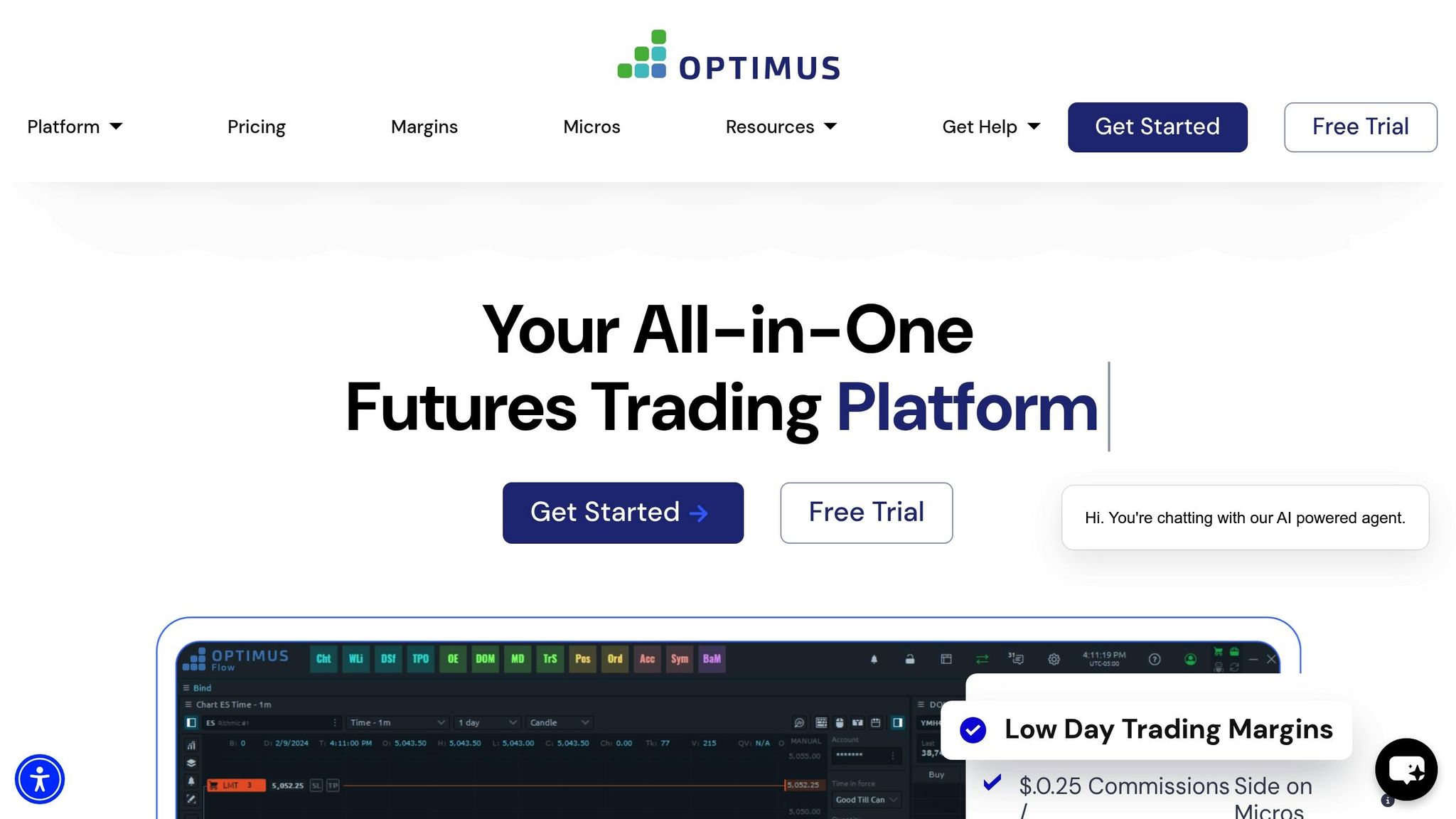
Optimus Futures rounds out our list as a futures broker tailored for cost-conscious retail traders who value both technology and personalized service. With a 4.5/5 star rating on Trustpilot, the broker has built a strong reputation, thanks to its low commissions, free proprietary platforms, and comprehensive support for traders of all experience levels. This combination of affordability and service creates a solid foundation for its feature-rich offerings.
Platform Features
Optimus Futures provides a mix of proprietary and third-party platforms to meet diverse trading needs. Its flagship platform, Optimus Flow, offers professional-grade tools without charging platform fees. Optimus Flow is designed with an intuitive interface and includes advanced features like unlimited charting and over 50 pre-built technical tools. Traders can place orders directly from charts, the Depth of Market (DOM), or a console, with support for advanced order types like bracket orders and One-Cancels-Other (OCO) orders.
The platform also stands out for its analytical tools. Features like the DOM Surface provide real-time visualizations of order flow and liquidity changes, while volume analysis tools break down volume distribution at each price level. TPO Profile charts offer insights into trading activity based on time and price, and additional enhancements such as custom alerts, automated journaling, and over 40 customizable panels make the platform highly versatile.
For traders seeking simpler options, Optimus Futures provides a free web-based platform and mobile app. These platforms deliver accurate market data, robust DOM Trader functionality, Market Replay for backtesting strategies, and powerful charting tools.
Pricing (USD)
Optimus Futures offers competitive commission rates, starting at just $0.25 per side for micro contracts and $0.75 per side for standard contracts. Several services are included at no extra cost, such as free CME Market Data (Level 1), routing, a trading journal, and real-time news alerts. This pricing structure aligns with a focus on affordability and value.
All proprietary platforms – Optimus Flow, the web platform, and the mobile app – are free for clients. Traders also benefit from unlimited simulated trading at no charge, allowing them to test strategies without financial risk. Additionally, day trading margins start as low as $50 for micro contracts and $500 for E-mini contracts, making it an attractive option for active traders.
Execution Speed
Optimus Futures leverages Rithmic’s R|Diamond technology to deliver sub-millisecond execution speeds, which is crucial for time-sensitive trading strategies.
"If you have developed strategies that rely on scalping and are highly time-sensitive, Rithmic’s R|Diamond solution could help you achieve sub-millisecond execution speeds. However, to realize such low latencies, you would likely need to co-locate your equipment in the same data center as Rithmic’s matching engines." – Matt Z, Optimus Futures
In addition to its software capabilities, the broker offers access to multiple data feeds and has optimized its infrastructure to ensure fast order fills and reliable execution. This is particularly beneficial in volatile market conditions. For high-frequency traders, Optimus Futures emphasizes that achieving low latency also depends on optimizing market data feeds, IT infrastructure, and networking.
Trading Style Compatibility
Optimus Futures caters to a wide range of traders. Beginners benefit from user-friendly web and mobile platforms, personalized onboarding, and educational resources. The free simulation environment allows new traders to practice without financial risk.
For day traders and scalpers, Optimus Flow provides advanced order flow tools, real-time DOM Surface visualizations, and ultra-low latency execution. Combined with low day trading margins, these features help keep frequent trading affordable. Swing and position traders can take advantage of extensive charting tools, technical indicators, and automated journaling to support longer-term strategies. Automated trading enthusiasts are also supported through integrations with platforms like MultiCharts and Sierra Chart for strategy development and backtesting.
Platform Integration
Optimus Futures enhances its offerings with seamless platform integration. The broker connects with TradingView, enabling mobile traders to use familiar charting and analysis tools. For more advanced needs, Optimus Futures supports professional platforms like Sierra Chart for low-latency trading and MultiCharts for strategy development and backtesting.
Platform Comparison: Strengths and Weaknesses
This section highlights the key features and limitations of various trading platforms, making it easier to find one that suits your needs. According to professional traders, switching to advanced platforms can boost productivity by 30–50%.
NinjaTrader is a strong choice for traders focused on automation, thanks to its powerful tools and a wide range of third-party add-ons. However, its complex interface can be daunting for beginners. Tradovate, on the other hand, shines with its browser-based platform and modern design, although it lacks some advanced order flow tools.
Interactive Brokers’ Trader Workstation offers institutional-grade execution and broad market access, earning it Investopedia’s top spot for professional traders. That said, some users have reported issues with customer support. Its tiered commissions are attractive for high-volume traders, with rates starting at $0.85 per contract for monthly volumes under 1,000 contracts.
Thinkorswim stands out for its research tools and educational materials, making it a great option for swing traders and those looking to build their skills. Supported by Charles Schwab’s customer service, it does come with higher per-contract fees of $2.25. Meanwhile, TradeStation offers extensive customization for experienced traders but has a steeper learning curve due to its less intuitive interface.
TradingView is popular for its social trading features and accessibility across devices, with monthly pricing ranging from $15 to $60. However, its order flow tools fall short compared to platforms designed specifically for that purpose. For professional traders seeking ultra-low latency execution, Sierra Chart is a solid option at $36 per month, though it lacks mobile access.
Quantower combines robust market analysis tools with automation capabilities, while AMP Futures focuses on competitive pricing, even promising to beat any written commission quote. Optimus Futures rounds out the list with a 4.5/5 Trustpilot rating.
| Platform | Monthly Cost | Ideal For | Execution Speed | Mobile Access | Automation Support |
|---|---|---|---|---|---|
| NinjaTrader | $0–99 | Strategy development | Excellent | Limited | Outstanding |
| Tradovate | Varies | Browser trading | Very good | Excellent | Good |
| Interactive Brokers | $0 | Professional trading | Excellent | Good | Very good |
| Thinkorswim | $0 | Research & education | Good | Excellent | Good |
| TradeStation | $0 | Customization | Very good | Good | Excellent |
| TradingView | $15–60 | Social trading | Good | Outstanding | Good |
| Sierra Chart | $36 | Low-latency trading | Outstanding | None | Excellent |
| Quantower | Varies | Market analysis | Very good | Limited | Very good |
| AMP Futures | $0 | Cost efficiency | Good | Good | Good |
| Optimus Futures | $0 | Balanced approach | Outstanding | Good | Good |
These comparisons complement the detailed reviews above, helping you match platform features to your trading style. Pricing structures vary, with some platforms offering volume discounts. For instance, TradeStation’s $1.50 per side fee (plus $0.50 for micro futures) is competitive for frequent traders.
Integration capabilities also differ, especially for VPS hosting and automation. Many platforms support third-party tools, and specialized VPS providers can enhance performance by situating data centers close to exchanges like the CME, reducing latency.
For beginners, platforms like Thinkorswim and Tradovate offer user-friendly interfaces and strong educational resources, even if they come with slightly higher costs. Day traders and scalpers might prefer Sierra Chart, NinjaTrader, or Optimus Futures for their fast execution speeds and advanced order flow tools. Meanwhile, swing traders can benefit from TradingView’s charting features or Interactive Brokers’ comprehensive research tools.
Testing platforms with simulation accounts is a smart way to assess their performance without financial risk. This approach ensures your chosen platform aligns with your trading goals and experience level.
Final Recommendations
Choosing the right futures trading platform boils down to your trading style, budget, and technical requirements. Based on the comparisons above, here are tailored suggestions to help you find a platform that aligns with your needs.
For beginners, it’s wise to start with platforms that offer strong educational tools and practice accounts. Thinkorswim is a solid choice with its user-friendly interface and extensive learning resources, priced around $2.25 per contract. TradingView is another option, providing intuitive tools and educational materials, with subscription costs ranging from $15 to $60 per month.
Day traders and scalpers should focus on platforms that deliver fast execution and minimal latency. Interactive Brokers stands out with institutional-grade order execution and rates as low as $0.85 per contract. NinjaTrader, designed specifically for futures trading, offers advanced charting and flexible pricing, including lifetime licenses with rates starting at $0.59 per standard contract.
Swing traders benefit from platforms that blend robust research tools with flexible order management. Thinkorswim by Charles Schwab shines in this area, offering excellent market analysis tools at about $2.25 per contract. TradingView, a favorite among over 30 million active traders each month, combines charting and social trading features, with costs between $15 and $60 per month.
Algorithmic traders need platforms with reliable API access and automation capabilities. TradeStation offers strong customization options and API connectivity at approximately $1.50 per contract. NinjaTrader also supports automation, allowing users to develop and implement strategies seamlessly.
Before committing to a platform, consider testing it with a demo account. This helps you evaluate usability, execution speed, and customer service responsiveness. Be sure to calculate your monthly costs, including commission rates, data feed charges (which can range from $5 to $150 monthly), and any additional fees. Request a detailed fee breakdown to avoid surprises, especially during volatile market conditions.
Ultimately, the ideal platform should enhance your trading strategy, not force you to adapt to its limitations. Choose one that complements your approach and supports your goals.
FAQs
What should I look for in a futures trading platform?
When selecting a futures trading platform, pay close attention to speed, reliability, and fees – these are the backbone of a smooth trading experience. Opt for platforms that offer competitive margin rates, advanced trading tools, and an interface that’s intuitive and adaptable to your trading approach, whether you’re into day trading, swing trading, or using automated systems.
It’s also worth evaluating the platform’s execution speed, how well it integrates with your trading setups, and the quality of its customer support. The right platform should not only match your trading goals but also provide the tools and features necessary to trade with confidence and efficiency.
How do platform fees and pricing impact my trading costs?
The fees and pricing structures of trading platforms – like commissions, exchange fees, and other charges – have a big impact on your overall trading costs. Keeping fees low and transparent is especially important if you trade frequently, as it can make a noticeable difference in your expenses.
When evaluating platforms, don’t just focus on the base commission. Look out for additional charges, such as data access fees or withdrawal costs, which can add up quickly. Opting for a platform with a pricing model that aligns with your trading habits can make a meaningful difference in your long-term profitability.
Which futures trading platforms are best for beginners and which are better for advanced traders?
For those just starting out, easy-to-use platforms with straightforward interfaces and handy tools are the way to go. Options like TradingView and Optimus Web & Mobile stand out for their clean design and beginner-friendly features that make navigating the trading world less intimidating.
On the other hand, seasoned traders often look for platforms packed with advanced tools and the flexibility to customize. Platforms such as TradeStation and Interactive Brokers are favorites among pros, thanks to their powerful charting capabilities, lightning-fast execution, and extensive customization options.
Ultimately, the best platform for you will depend on your skill level, trading objectives, and the tools you need to achieve your goals.








